How to visit Newgrange Ireland: A Sacred site
A visit to Newgrange Ireland has always been on the top of my must-see list and I have to say it lived up to every expectation I had. Newgrange is a very short trip from Dublin and makes an ideal day trip.
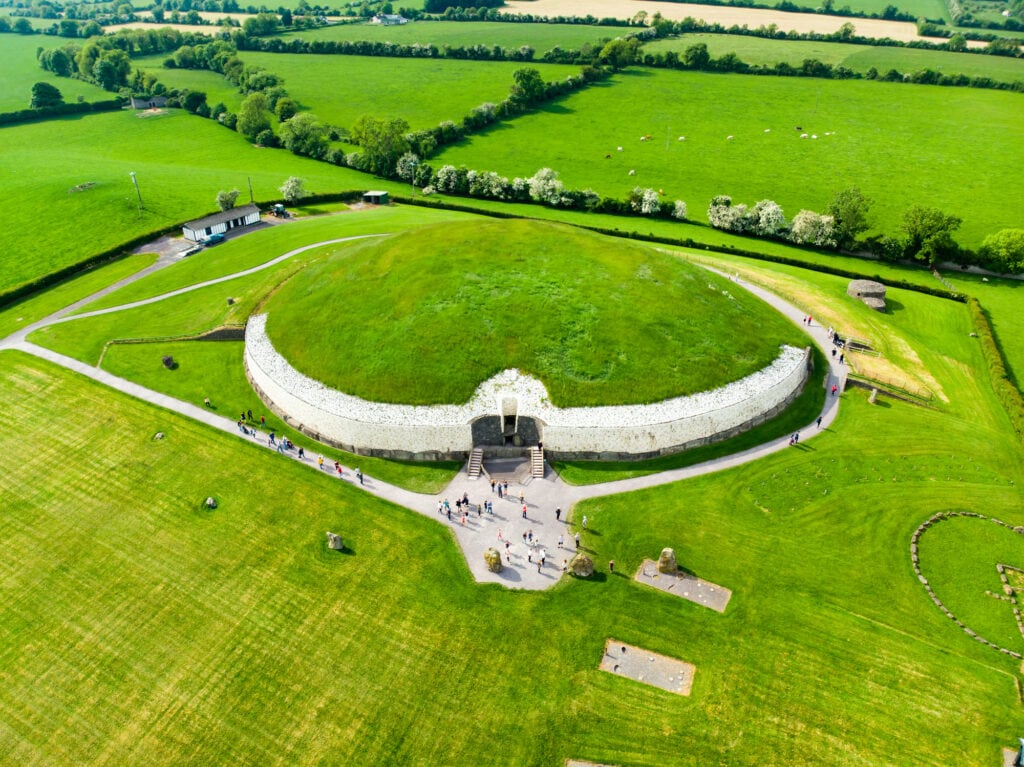
Newgrange is a Stone Age (Neolithic) monument in the Boyne Valley, County Meath, it is the jewel in the crown of Ireland’s Ancient East and a UNESCO World Heritage Site.
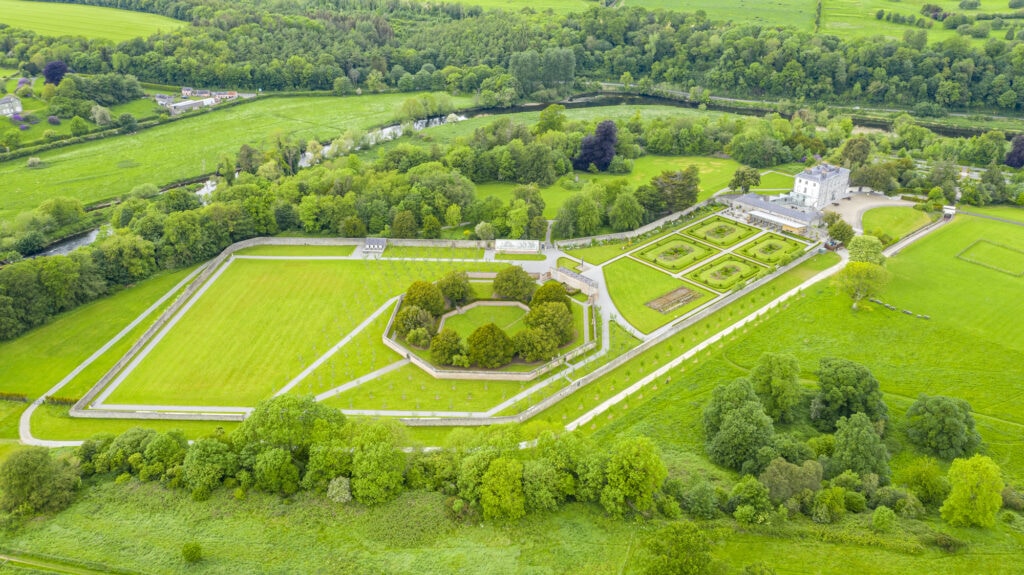
Planning a first-time trip to Ireland – Here is what you need to know before you go
Visit Newgrange from Dublin
How to get to Newgrange and how far is Newgrange from Dublin? The drive to the Brú na Bóinne Visitors Centre which is where Newgrange is accessed is relatively easy from Dublin if you have rented a car. The drive from Dublin takes around 40-45 minutes.
There are no buses from Dublin to Newgrange and the centre however there are many tours that will take you to the area and include other stops along the way including Monasterboice and Kells which is where the Book of Kells was found. The cost is around €35+ Euros and will take up a whole day.
Map of Newgrange Ireland
Need to rent a car in Ireland? Here’s all you need to know
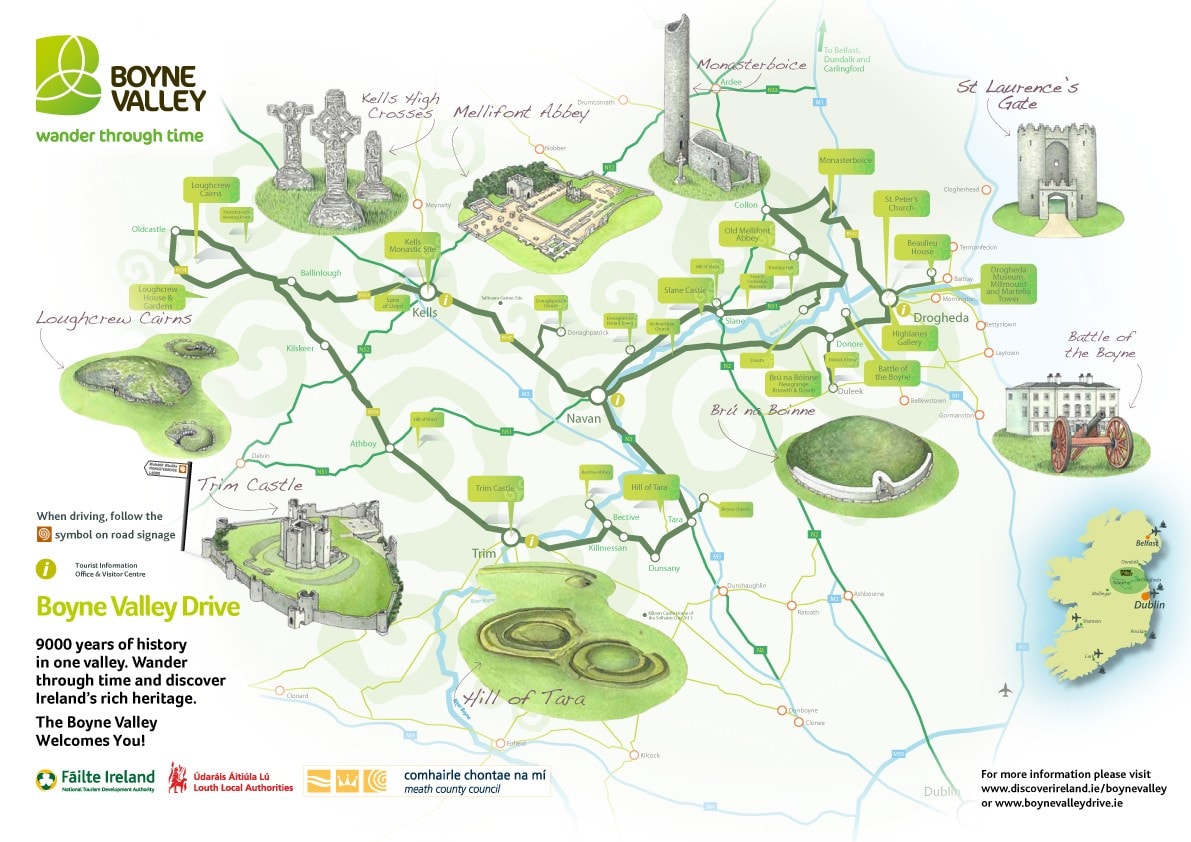
Newgrange facts
Tickets for Newgrange Tomb
You can’t see Newgrange from the road that leads to the Brú na Bóinne Visitor Centre. You will walk down a shaded pathway from the parking lot (which is accessible for all including wheelchairs) that leads to the centre. You will get your ticket at a cost of €10 Euros for a guided tour and that will give you access to the megalith and the museum, all access to the monument is controlled via the visitors’ centre, which has been recently renovated, which helps maintain the integrity and security of the site.
Newgrange Hours
Visitors are brought via shuttle bus to these monuments and pre-booking tickets is essential. Pre-booking for the Visitor Centre only is not required. Generally speaking depending on the season Newgrange can be toured from 9 am until 5.45pm.
Newgrange and Knowth tour
BRÚ NA BÓINNE TOUR + NEWGRANGE CHAMBER+KNOWTH €18.00
A guided tour to Knowth and Newgrange includes access to the chamber at Newgrange. Includes exhibitions at Knowth and Brú na Bóinne Visitor Centre. No access to the chambers at Knowth.
NEWGRANGE TOUR + EXHIBITION €10.00
A guided tour to Newgrange includes access to the chamber. and includes the exhibitions at Brú na Bóinne Visitor Centre.
How long is the Newgrange Tour? The tour will take around 2 hours and you cannot go on a tour without pre-booking online.
Accessibility of Newgrange Tomb
Once you purchase your ticket, you will take a short walk over the River Boyne and up to the area where the shuttle buses will take you to the site. This is all completely accessible and the buses do have wheelchair lifts. Once you arrive at the site, you will wait for a guide to take you up to the tomb. The pathway to the tomb is paved and you will be able to use a wheelchair around the site. Access into the tomb is through a narrow passageway and may not be possible with a wheelchair but a walker would be fine.
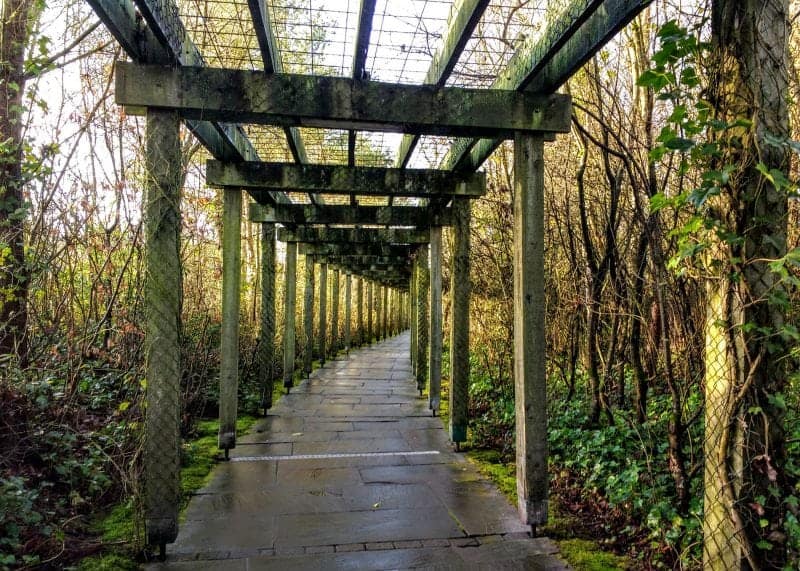
History of Newgrange Tomb
Newgrange is a Neolithic monument that was constructed about 5,200 years ago (3,200 B.C.) which makes it older than Stonehenge and the Great Pyramids of Giza. Newgrange is a large circular mound 85 meters (93 yards) in diameter and 13.5 meters (15 yards) high with a 19-meter (21 yards) stone passageway and chambers inside. The mound is ringed by 97 large curbstones, some of which are engraved with symbols of megalithic art.
A circle of standing stones also surrounds Newgrange. Nobody is really sure why and what they mean but it appears to be of some kind of astrological function. The Stone Circle was erected sometime after 2000 BC and research has shown that one of the stones of the circle lies directly on top of the Early Bronze Age Pit Circle.
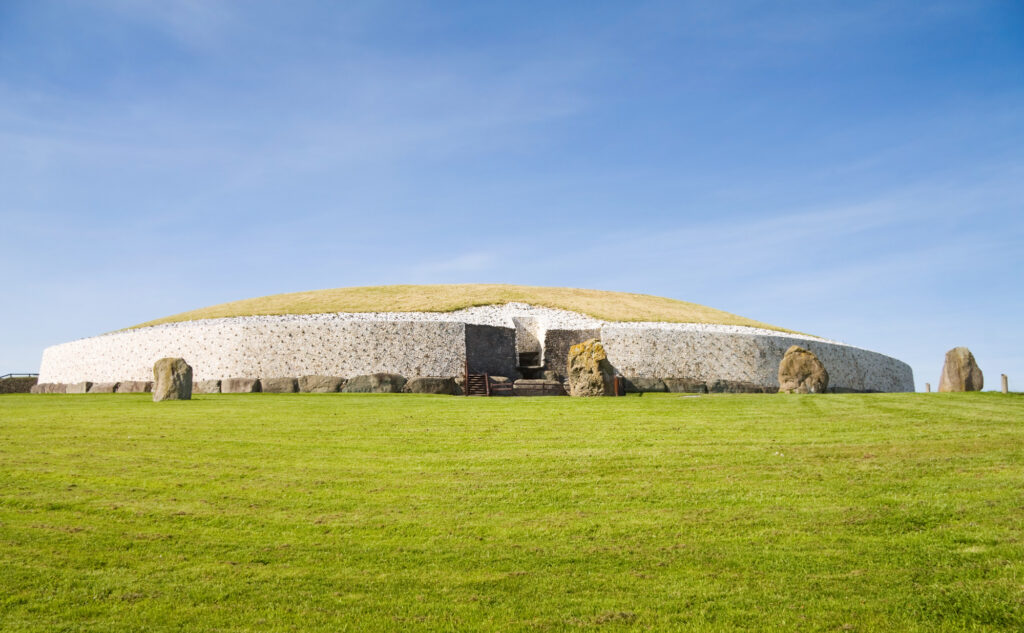
Who built Newgrange Ireland?
Newgrange was built by a farming community that lived on the rich lands of the Boyne Valley. Knowth and Dowth are similar mounds that together with Newgrange have been designated a World Heritage Site by UNESCO. You can also see from the front of the tomb smaller tombs down in the valley that are waiting to be excavated.
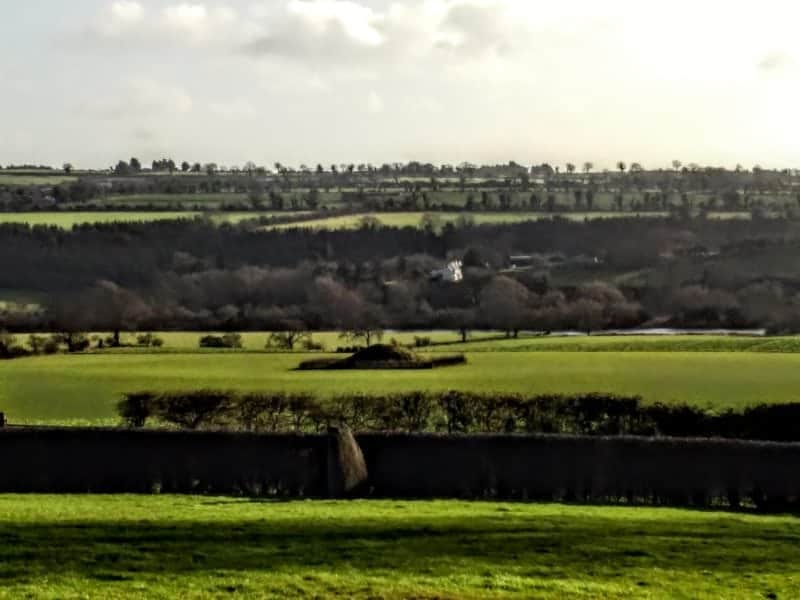
Excavations began in 1962 and revealed that the tomb at Knowth was what is known as a multi-period site. There are 18 smaller tombs surrounding the largest mound, at least two of which are even older than it is. Dowth is the least well-known of the three great tombs of the Boyne Valley. It has not yet been excavated, but initial investigations reveal two passage tombs within the mound.
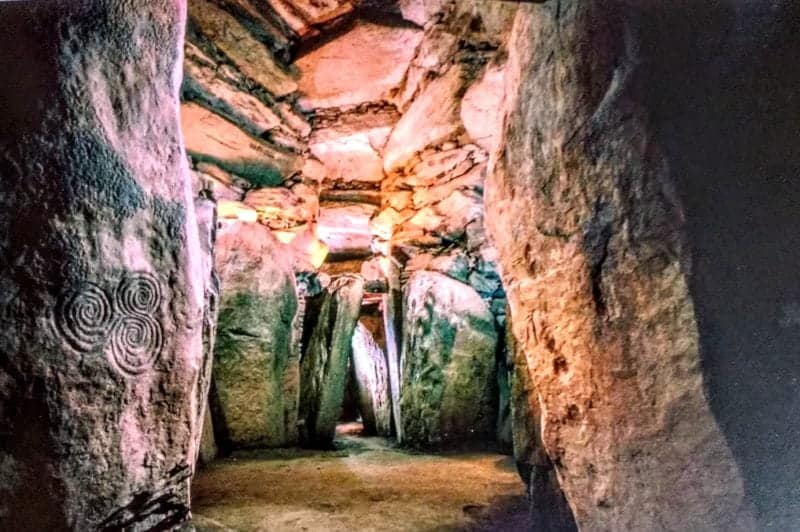
Newgrange and Irish Mythology
In local legend, Newgrange was believed to be the home of Aengus óg and the Daghdha, who were the gods of the Tuatha Dé Danann. It was said that Newgrange served as the dwelling place of Aengus óg, the son of Daghdha and the river goddess Bóann. Their story is one of love and secrets. To hide themselves and their secret love, Daghdha ordered the sun to halt its journey for nine months, resulting in Aengus’s conception and birth occurring on the very same day. Legend says this is how he became named “Aengus óg,” meaning “Aengus the Young.”
When he learned that he would inherit nothing he decided upon a plan to win Newgrange for himself. He asked Daghdha if he could stay at the site for “a day and a night,” and his father said yes. Later however, Aengus argued that “a day and a night” encompassed “all days and all nights.” In this way, Daghdha was outwitted, and Aengus assumed ownership of Newgrange.
Aengus fell deeply in love with a maiden named Caer, whom he had seen in a dream. For a year, he embarked on a quest across Ireland in search of her, but his efforts proved futile. Finally, Aengus located her, only to find her bound in chains alongside 150 other maidens. It was revealed that on every alternate Samhain, the girls would transform into swans for a year. Aengus was informed that if he could identify Caer among the swans, she would become his wife.
Calling out to the swan named Caer, Aengus ventured into the lake and touched her. In a magical transformation, he too turned into a swan. The legend recounts that they soared together to Brú na Bóinne, where they enchanted the inhabitants of the ancient tombs with their mesmerizing songs.
Visiting Newgrange Ireland
Of the three main passage tombs in the Boyne Valley, Newgrange has always attracted the most attention. Little did anyone know that the tomb held a secret that was not revealed for many years. Archaeologists initially classified Newgrange as a passage tomb, but these days it is recognized as a much more important site and more likely a temple of worship. It is a place of great religious and spiritual significance which is abundantly clear when it comes time to celebrate the Winter Solstice.
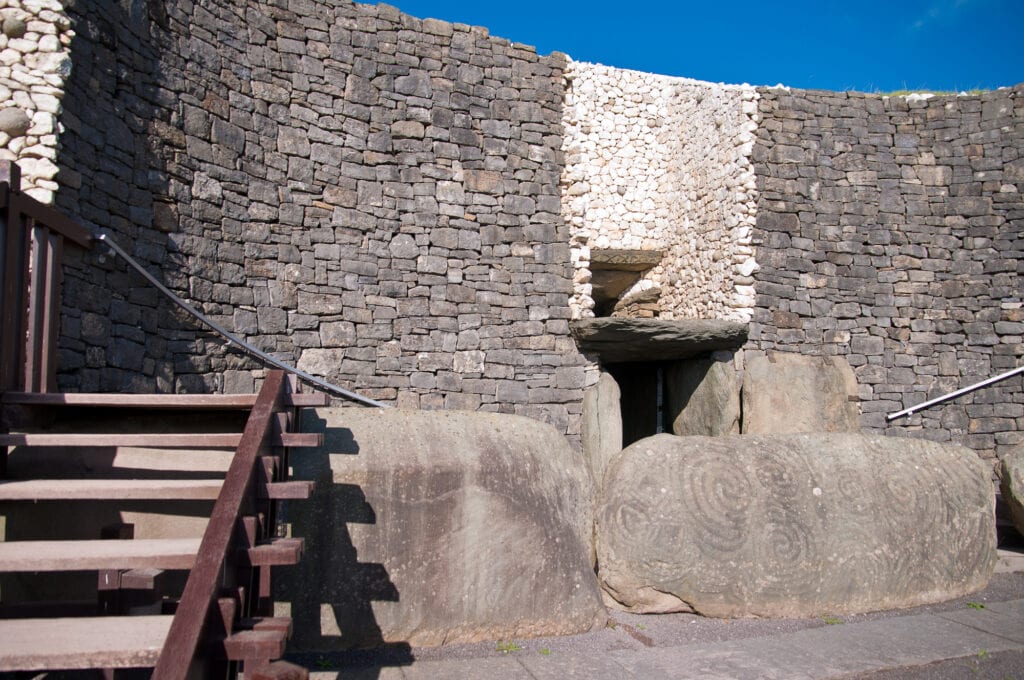
Access to Newgrange is past the entrance stone to the tomb which is carved with triskeles an ancient Celtic symbol.
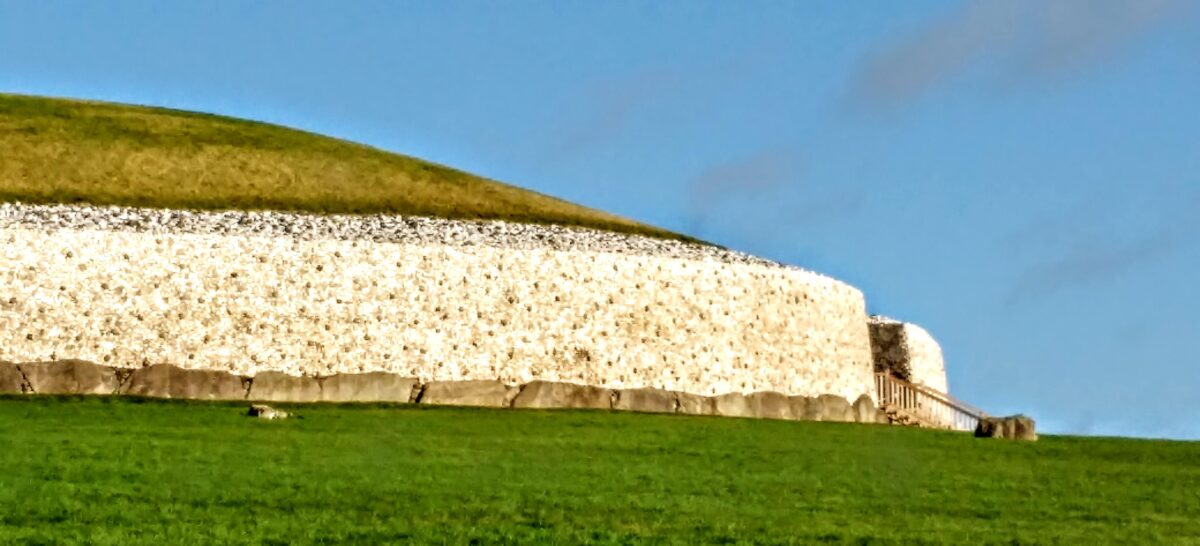
Inside Newgrange tomb
The entry into the passage and chamber is less than 60 feet long and leads into a chamber with three side recesses. This chamber is roofed by a corbelled roof vault, which has remained intact and watertight without any conservation or repair. The cairn (stone mound) that covers the chamber is estimated to weigh 200,000 tonnes and is retained at its base by 97 massive curbstones.
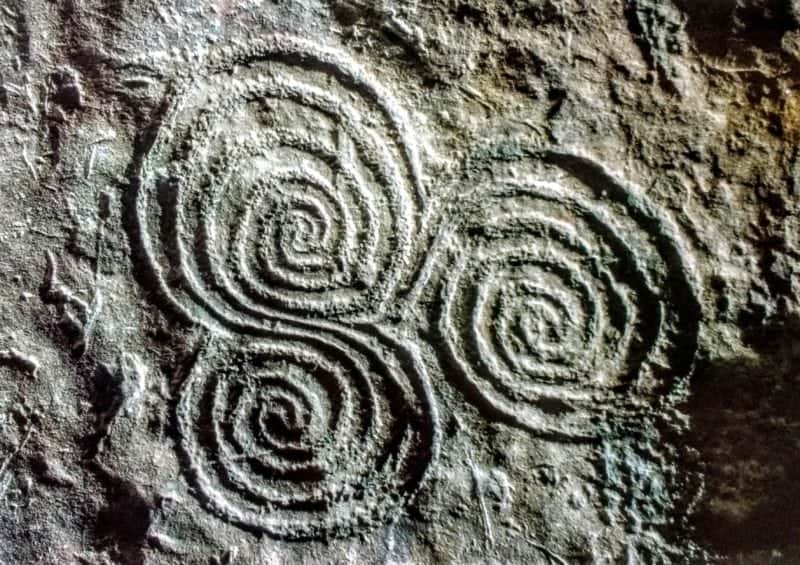
As you enter, the recess on the right side of the tomb is the largest and most ornately decorated. On the floor lie, two stone basins, one inside the other. The outer basin is shaped from solid granite, as opposed to the other two recesses, which were carved from sandstone.
Archaeologists believe that these stone basins once held the remains of the dead. The remains of five bodies were recovered inside, though the original number was believed to be much higher. The tomb was disturbed prior to excavation it remains unknown how many might have been interred here. Most of the bones found had been cremated, with only small amounts left unburned. The artefacts found with the bones were beads made of bone as well as pendants and polished stone balls.
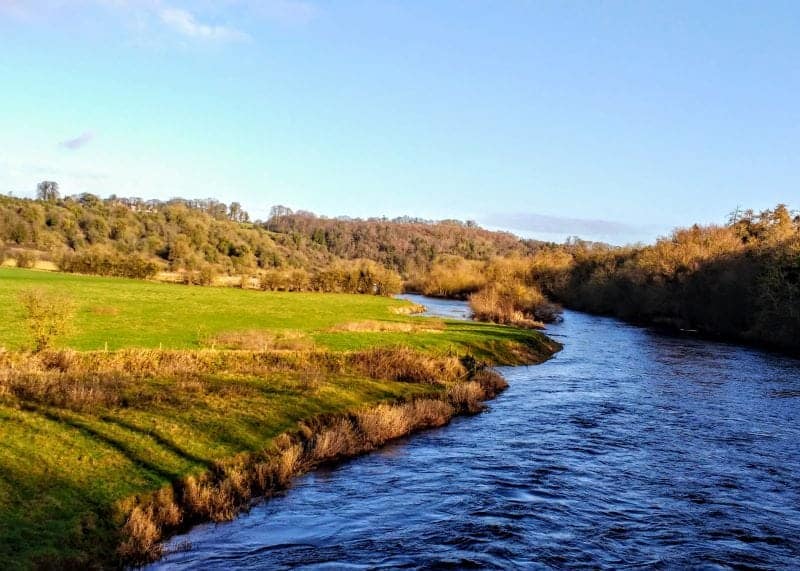
A stone circle of 12 menhirs (upright boulders) surrounds Newgrange. Originally, there may have been more, but after the excavation of the woodhenge; it became clear that the stone circle was erected sometime after 2000 B.C.
It was in 1962 that the first major excavation of the site began. After the excavation, the interior passage was straightened and enclosed by a second passage (now unseen) in order to relieve the pressure from the weight of the mound. The original facade of white quartz was rebuilt using stone found at the site. The height and angle of the facade match the original and were calculated by measurements taken from the collapsed retaining wall.
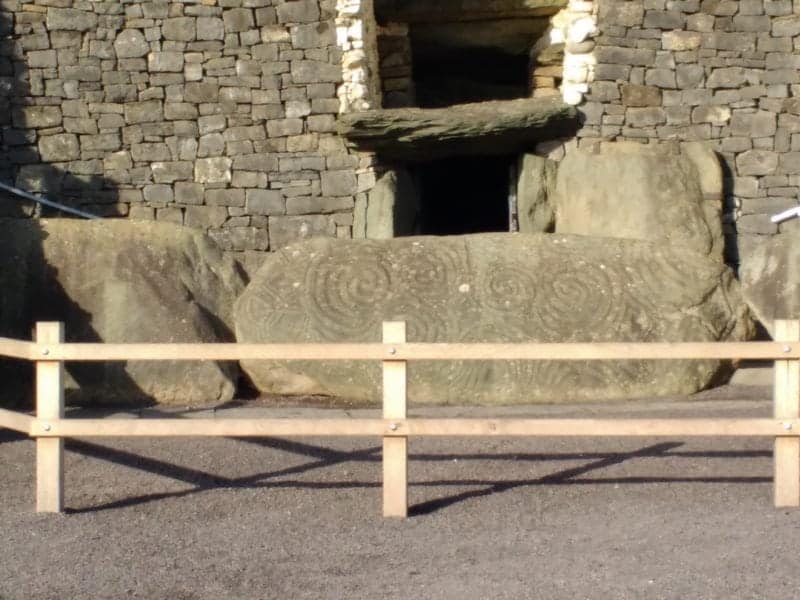
Above the entrance to the passage at Newgrange, there is a window-like opening called a roof box. This was the secret of Newgrange because until it was discovered no one was aware that sunlight penetrates the chamber on the shortest days of the year, around December 21, the winter solstice.
At dawn, a narrow beam of light penetrates the roof box and reaches the chamber floor, gradually extending to the rear of the passage. As the sun rises higher, the beam widens within the chamber so that the whole room becomes dramatically illuminated. This event lasts for 17 minutes, the tour guides at the site demonstrate this within the tomb and it is an awe-inspiring sight to see that golden light coming into the tomb and ending in a point at the back wall.
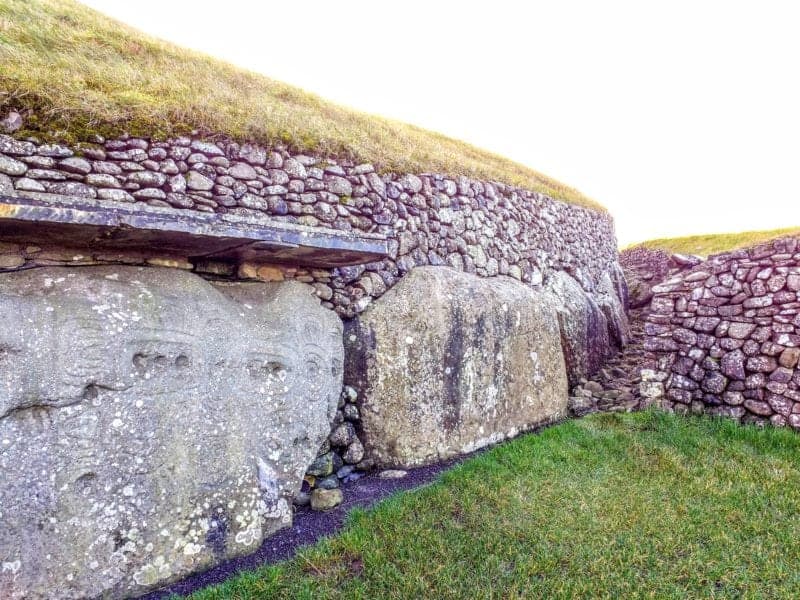
Newgrange Solstice Celebrations
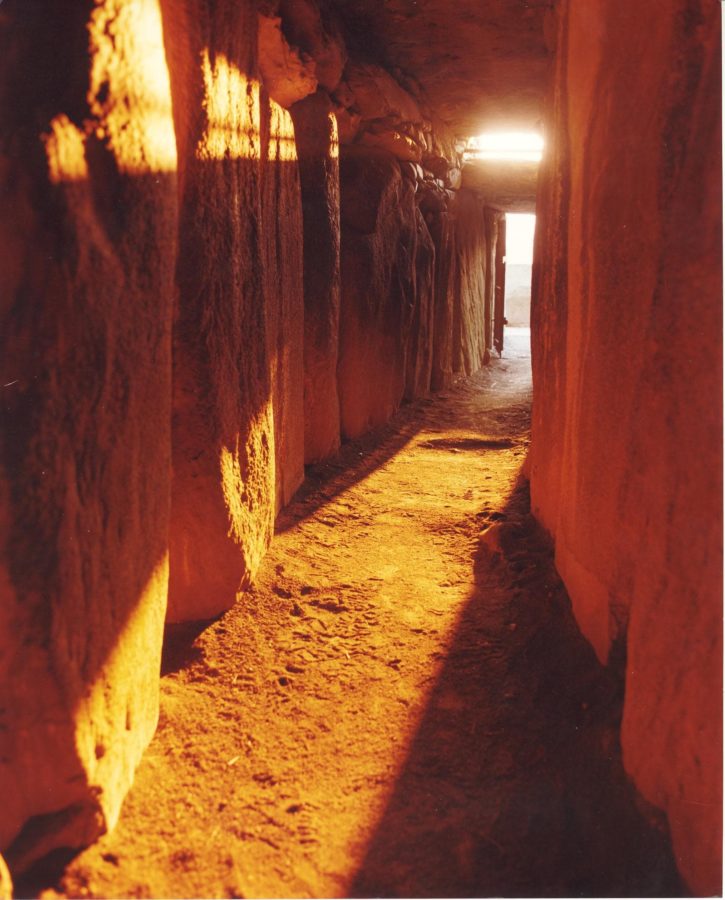
Each year the winter solstice event at the Newgrange tomb is a remarkable celebration, there are many who want to attend the solstice happening and they gather at dawn to see this event. There are so many and the tomb is so small that Newgrange holds a lottery every year to grant access to the few that can fit in the tomb. It must be one of those life events that will live in your memory forever.
The guides at Newgrange are incredible, their passion, their storytelling and their love for the place are unparalleled we are grateful that the tours are guided by such passionate, devoted caretakers who make the experience that much more profound.
You can read lots more about great day trips from Dublin and ancient sites all over the country, here are a few selections.
